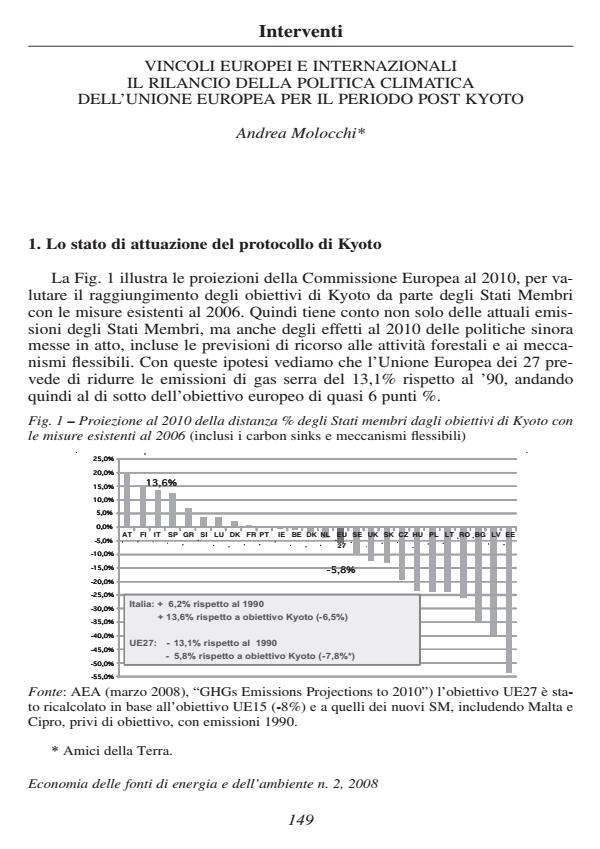Vincoli europei e internazionali. Il rilancio della politica climatica dell'Unione Europea per il periodo post Kyoto
Titolo Rivista ECONOMIA DELLE FONTI DI ENERGIA E DELL’AMBIENTE
Autori/Curatori Andrea Molocchi
Anno di pubblicazione 2009 Fascicolo 2008/2
Lingua Italiano Numero pagine 13 P. 149-161 Dimensione file 640 KB
DOI 10.3280/EFE2008-002010
Il DOI è il codice a barre della proprietà intellettuale: per saperne di più
clicca qui
Qui sotto puoi vedere in anteprima la prima pagina di questo articolo.
Se questo articolo ti interessa, lo puoi acquistare (e scaricare in formato pdf) seguendo le facili indicazioni per acquistare il download credit. Acquista Download Credits per scaricare questo Articolo in formato PDF

FrancoAngeli è membro della Publishers International Linking Association, Inc (PILA)associazione indipendente e non profit per facilitare (attraverso i servizi tecnologici implementati da CrossRef.org) l’accesso degli studiosi ai contenuti digitali nelle pubblicazioni professionali e scientifiche
The European and International context. The Energy and climate EU policy for the post Kyoto period - The relation describes the European strategy on energy and climate under the UNFCCC process for the post Kyoto period (after 2012), by which on march 2007 the EU Council adopted general targets at 2020 for a 20%/30% emission reduction, 20% renewables and 20% energy saving. Furthermore it highlights the main features of the legislative proposals published by the European Commission (EC) to implement the strategy on the 23rd January 2008, soon after the Bali COP13 (so called "energy and climate package"). The package contains proposals to implement the 20% emission reduction through EU level defined caps in the ETS sectors and by national targets differentiation in the non-ETS sectors (respectively under the "ETS revision directive" and "Effort Sharing Decision") and a further directive proposal to implement the 20% target for renewables through national target differentiation as well. The burden sharing criteria applied by EC in the energy package proposals are based on GDP per capita and they do not consider any environmental efficiency criteria, such as carbon intensity or potential for renewable sources based on land availability. As the Impact Assessment produced by the Commission itself shows, the way the "solidariety criteria" has been applied produced estimated costs on GDP highly differentiated between Member States and non-coherent with the GDP per capita distribution. Nevertheless, these burden sharings have not been timely corrected by the EC to bring optimisation with GDP per capita rankings in the UE. In addition, the EC package does not contain legislative proposals aimed to implement the 20% energy saving target. Recent disclosure of information by EC consultants (NTUA - Primes Model) shows that the implicit energy saving potential of the proposed package is limited to 7%, thus far away from the announced 20%. Due to these lackings, the EC package and related burden sharings may not be considered coherent to the EU Council spring 2007 mandate. European Parliament or Council emendments aimed at a higher efficiency and fairness for the whole package are deemed necessary by the author, even if politically difficult to be introduced.
Key words: Energy & climate package, GHGs, energy efficiency, renewable sources, European policy.
Andrea Molocchi, Vincoli europei e internazionali. Il rilancio della politica climatica dell'Unione Europea per il periodo post Kyoto in "ECONOMIA DELLE FONTI DI ENERGIA E DELL’AMBIENTE" 2/2008, pp 149-161, DOI: 10.3280/EFE2008-002010